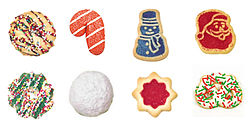Christmas cookies

A variety of decorated Canadian- and American-style Christmas cookies
|
|
| Type | Sugar biscuits and cookies |
|---|---|
| |
|
Christmas cookies or Christmas biscuits are traditionally sugar cookies or biscuits (though other flavours may be used based on family traditions and individual preferences) cut into various shapes related to Christmas.
Modern Christmas cookies can trace their history to recipes from Medieval Europe biscuits, when many modern ingredients such as cinnamon, ginger, black pepper, almonds and dried fruit were introduced into the west. By the 16th century Christmas biscuits had become popular across Europe, with lebkuchen being favoured in Germany and pepparkakor in Sweden, while in Norway krumkake were popular.
The earliest examples of Christmas cookies in the United States were brought by the Dutch in the early 17th century. Due to a wide range of cheap imported products from Germany between 1871 and 1906 following a change to importation laws, cookie cutters became available in American markets. These imported cookies cutters often depicted highly stylised images with subjects designed to hang on Christmas trees. Due to the availability of these utensils, recipes began to appear in cookbooks designed to use them. In the early 20th century, U.S, merchants were also importing decorated lebkuchen cookies from Germany to be used as presents.
In Canada and the United States, since the 1930s, children have left cookies and milk on a table for Santa Claus on Christmas Eve, though many people simply consume the cookies themselves. The cookies are often cut into such shapes as those of candy canes, reindeer, and holly leaves.
...
Wikipedia
